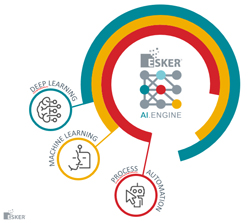2019 Supply Chain Predictions from the Analysts Part 1
Over the past two weeks, as usual I have summarized predictions for 2019 from a great virtual panel of supply chain gurus.
You can find those columns here: Supply Chain Guru Predictions for 2019 and Supply Chain Guru Predictions for 2019- Part 2.
| GILMORE SAYS: |
Many pundits are afraid of saying the blockchain emperor has no clothes. Glad to see Gartner is not.
WHAT DO YOU SAY?
Send us your
Feedback here
|
Over the next two weeks, I am going to finally wrap this up with predictions from the analysts, starting these with Gartner, where a bevy of analysts (Dwight Klappich, Rick Franzosa, Christian Titze, Alex Pradhan, and Andrew Stevens) offer a series of interesting prognostications as always.
Let's start with this one: By 2023, over 30% of operational warehouse workers will be supplemented, not replaced, by collaborative robots.
Gartner says next-generation autonomous mobile robots (AMRs) are transforming warehouse operations, as these machines become more autonomous and intelligent.
The costs and operational complexities of these robots are coming down, Gartner says, which opens the market to more companies.
While reducing labor is the primary demand driver, as with most DC automation improvements increasing facility throughput is also an adoption driver, regardless of whether labor is reduced, Gartner says.
In Gartner's Supply Chain Technology User Wants and Needs Survey (based on a survey of SCDigest readers), respondents were asked about their investment plans for emerging technologies. For those respondents that indicated they have already invested in or are planning to invest in IoT or robotics, 17% said they will be either replacing conventional material handling automation with robots or buying robots within the next three years.
What's more, when asked what the current state of their organization's pursuit of advanced automation in their warehouse or factories is, 60% of respondents were conducting knowledge gathering, strategy development and requirements documentation, and another 17% of respondents were piloting AMRs.
So what's the takeaway from all that?
Gartner notes that "AMRs add intelligence, guidance and sensory awareness to historically 'dumb' automated guided vehicles (AGVs), allowing them to operate independently and around humans. AMRs address the historic limitations of traditional AGVs, making them better suited to, and more cost-effective for, complex warehouses."
Gartner says AMRs are primarily collaborative robots that support, not replace, people. Applications include order picking, where the robot follows a person as he or she case picks, and then autonomously navigates between aisles and to the shipping dock; pick to cart, in which, again, the robot does the moving, and the human simultaneously picks and places multiple orders into totes on the cart; and goods-to-person scenarios, where the robots deliver goods to and from people that stay in one place (sometimes, I will note, this is called "task to person.")
"This is why we believe that warehouse workers will be supplemented, not replaced, by robots," Gartner says.
I say this is largely true, and note that there is a growing DC labor crisis in most markets. But also coming are more automated case and piece picking robots that are a real threat to take DC jobs.
Next is a more provocative prediction: By 2023, 20% of warehouse transactions will be processed via augmented reality and/or conversational Voice technologies.
"Technologically mature warehouse operations have maxed out the productivity benefits of core warehouse management systems (WMS) and basic mobile technologies like ruggedized radio frequency terminals and scanning devices," Gartner says. What's more, many of these same organizations have already adopted transactional Voice technologies as well. Many companies struggle to find incremental value from their existing technologies, but are also unwilling or unable to step up to advanced material handling automation.
So that may mean augmented reality (AR) or conversational Voice technologies may come to the rescue of firms in this productivity plateau.
AR involves using smart glasses, and the technology is advancing. AR vendors are extending the functional reach to do things previous mobile technologies struggled with, Gartner says. For example, several of the vendors are demonstrating things like "virtual" pick-to-cart scenarios.
What does that mean?
"Historically, in pick to cart, there was the physical cart and generally a paper pick list, and then separate mobile device like a tablet or lights installed on the cart would highlight what needed to be picked and put where on the cart," Gartner notes, adding that "this worked, but paper was inefficient, the tablets were often inconvenient to reference, and the lights were expensive to install and maintain. Now, a virtual rendering of the cart can be displayed in the user's field of vision with where to put items highlighted visually in the smart glasses.
"Although adoption to this point has been slow, this will soon change," Klappich predicts. As the cost of hardware and software falls, adoption will increase.
Voice technology, in which work is communicated to associates via spoken words using a headset and the worker confirming activities using words as well, has high rates of adoption in distribution.
"Conversational" Voice, by contrast, involves ad hoc inquiry capabilities like "Do I have any late orders?" or "Where else do I have product X?" Such technology is in the very early stages in the DC, Klappich says, but is likely to grow rapidly soon.
I frankly am not as bullish as Klappich on AR. There is some interesting stuff being developed for sure, but I think 20% of transactions using AR by 2023 is a stretch.
The last Gartner prediction I will use is this, and it is another provocative one: By 2023, 90% of blockchain-based supply chain initiatives will suffer blockchain fatigue for lack of strong use cases.
Of course the blockchain hype machine is in high gear in many quarters, though we will note our guru prognosticator Mike Watson last week predicted a largely blockchain bust in the supply chain.
Gartner gets straight to the point: "Success in the early years of supply chain blockchain projects is very limited, with initiatives failing to match the initial market exuberance that will lead to disillusionment and buyer fatigue."
There is interest for sure. For example, over the last two years, blockchain has been the No. 1 trending topic on gartner.com.
However, Gartner says, "Supply chain leaders across all industries are struggling to find suitable use cases for blockchain." In fact, The Gartner Supply Chain Technology User Wants and Needs Survey found that only about 19% of respondents saw blockchain as a very important technology and only about 9% have already invested in blockchain or have budgeted to do so in 2018.
This is largely because companies struggle to identify how blockchain will be a better offering and provide higher value over conventional technology.
And I like this comment: "Many companies at this point in time are pursuing blockchain projects due to intense pressure to be seen as having blockchain competency or due to pressure from the C-suite, rather than investing for specific purposes where blockchain is proven the best technology. This deepens the misalignment between need versus desire for a technology for the sake of a technology."
Many pundits are afraid of saying the blockchain emperor has no clothes. Glad to see Gartner is not.
"Be cautious with regard to early adoption, especially with regard to heavy investment," Gartner says. Here here!
There's more but I think I will end it here. Next week predictions for 2019 from the analysts at IDC and others.
An reaction to these Gartner Predictions? What resonates with you? What are some of your 2019 supply chain predictions? Let us know your thought at the Feedback button below. |



![]()

![]()

![]()











